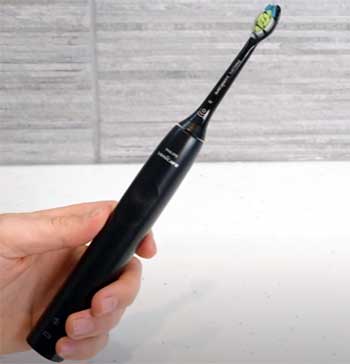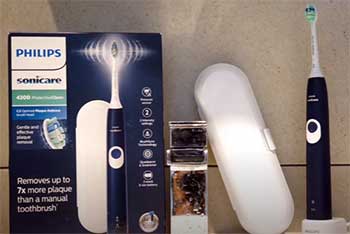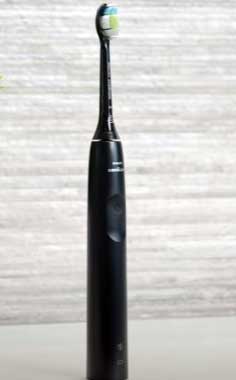When choosing a new toothbrush, the Sonicare 4100 and 4300 often come up as top contenders. Both are renowned for their effectiveness and innovative features, but which one suits your needs better?
In this article, I’ll compare these two models, highlighting their pros and cons, to help you make an informed decision.
Whether you’re upgrading from an older electric toothbrush or trying one for the first time, this comparison will provide you with the insights you need to choose the right Sonicare model for you.
A Brief Comparison Table
| Feature | Sonicare 4100 | Sonicare 4300 |
| Price | More affordable | Slightly more expensive |
| Battery Life | Up to 14 days | Up to 14 days |
| Brushing Modes | 1 mode | 1 mode |
| Pressure Sensor | Yes | Yes |
| BrushSync Technology | No | Yes |
| Brush Head Replacement | Manual reminder | Automatic reminder |
| Warranty | 2 years | 2 years |
| Design | Simple and functional | Simple and functional |
| Travel Case | No | Yes |
Sonicare 4100 Electric Toothbrush Overview

The Sonicare 4100 is a popular choice for those looking to maintain excellent oral hygiene without breaking the bank.
It comes with a single brushing mode, a two-minute timer, and a quad-pacer that ensures you spend an equal amount of time on each quadrant of your mouth.
The built-in pressure sensor is a great feature that alerts you if you’re brushing too hard, protecting your gums from damage.
Pros of Sonicare 4100
- Affordable: The Sonicare 4100 is priced lower than many other electric toothbrushes, making it an attractive option for budget-conscious buyers.
- Pressure Sensor: This feature helps you avoid brushing too hard, which can damage your gums and tooth enamel.
- Quad-pacer: Ensures that you brush your teeth evenly by dividing the mouth into four quadrants and prompting you to move to the next section after 30 seconds.
- Simple Design: It’s straightforward and easy to use, with no unnecessary frills.
- Battery Life: Lasts up to 14 days on a single charge, which is convenient for those who travel frequently.
Cons of Sonicare 4100
- Limited Features: Only one brushing mode might not be enough for those who prefer different settings for different needs.
- No BrushSync Technology: You’ll need to remember to replace the brush head manually, as there’s no automatic reminder.
- No Travel Case: This could be a drawback for those who travel often and want a protective case for their toothbrush.
Sonicare 4300 Electric Toothbrush Overview
The Sonicare 4300 is a step up from the 4100, offering additional features that might justify the slightly higher price. It includes all the features of the 4100, with the addition of BrushSync technology and a travel case.
The BrushSync technology syncs with the handle to monitor the usage of the brush head and alerts you when it’s time for a replacement.
Pros of Sonicare 4300

- BrushSync Technology: Automatically tracks brush head usage and alerts you when it’s time to replace it, ensuring optimal performance.
- Pressure Sensor: Like the 4100, it has a pressure sensor to prevent over-brushing.
- Travel Case: Comes with a travel case, making it convenient to carry your toothbrush while on the go.
- Battery Life: Up to 14 days of battery life, similar to the 4100, which is excellent for travel.
- Simple Design: Maintains a straightforward and functional design that’s easy to use.
Cons of Sonicare 4300
- Higher Price: It’s slightly more expensive than the 4100, which might not be justifiable for everyone.
- Single Brushing Mode: Just like the 4100, it only offers one brushing mode, which might be a limitation for some users.
- No Significant Design Difference: Apart from the added features, the design and feel are quite similar to the 4100, which might not appeal to those looking for a more advanced look.
Detailed Comparison of Sonicare 4100 And 4300 Toothbrushes
- Brushing Experience
Both the Sonicare 4100 and 4300 provide an excellent brushing experience. They use Sonicare’s patented sonic technology to deliver up to 31,000 brush strokes per minute. This high-frequency brushing action helps remove plaque and improve gum health.
The 4100 and 4300 both come with a single brushing mode, which is sufficient for most users. However, if you’re someone who likes to have multiple modes for different needs (such as a sensitive mode or a deep clean mode), you might find this limitation frustrating.
- Battery Life and Charging
One of the standout features of both the 4100 and 4300 is their impressive battery life. Both models can last up to 14 days on a single charge. This is particularly useful for travelers who might not have access to a charger for a couple of weeks.
The charging process is simple and straightforward. Both models come with a compact charging base that takes up minimal space on your bathroom counter.
- Pressure Sensor
The pressure sensor is a valuable feature in both the 4100 and 4300 models. It helps prevent over-brushing, which can lead to gum damage and enamel erosion.
When you brush too hard, the toothbrush will alert you with a gentle pulsing sound, allowing you to adjust your brushing pressure.
- BrushSync Technology
One of the significant differences between the Sonicare 4100 and 4300 is the BrushSync technology. The 4300 is equipped with this feature, which tracks the usage of your brush head and alerts you when it’s time to replace it.
This ensures that you’re always using an effective brush head, which can improve your overall oral hygiene.
The 4100, on the other hand, does not have BrushSync technology. You’ll need to keep track of your brush head usage manually and replace it every three months or when the bristles start to fray.
- Design and Usability
Both models have a simple and functional design that’s easy to use. They feature a slim, ergonomic handle that’s comfortable to hold. The power button is conveniently located, and the overall design is straightforward, making it easy for anyone to use.
The 4300 comes with a travel case, which is a nice addition for those who travel frequently. It keeps your toothbrush protected and clean while on the go. The 4100 does not include a travel case, which might be a drawback for some users.
- Cost and Value

Price is often a deciding factor when choosing between two similar products.
The Sonicare 4100 is more affordable than the 4300, making it a great option for those on a budget.
However, the additional features of the 4300, such as BrushSync technology and the travel case, might justify the higher price for some users.
If you’re looking for a basic, reliable electric toothbrush, the 4100 is a fantastic choice.
It provides all the essential features you need for excellent oral hygiene.
However, if you’re willing to spend a bit more for added convenience and advanced features, the 4300 might be worth the investment.
Frequently Asked Questions (FAQ)
Yes, many dentists recommend TheraBreath products because they are designed to fight bad breath and improve oral health. TheraBreath formulas often include oxygenating compounds that help neutralize bad breath-causing bacteria.
Absolutely, the Sonicare 4100 is more than good enough for maintaining excellent oral hygiene. It offers essential features like a pressure sensor, quad-pacer, and long battery life, making it a great choice for most users.
The best model of Sonicare toothbrush depends on your specific needs and budget. The Sonicare DiamondClean Smart is often considered the top model due to its advanced features, but for everyday use, both the Sonicare 4100 and 4300 are excellent choices.
If your current Sonicare toothbrush is old or lacking features that you find beneficial, it might be worth upgrading. Models like the Sonicare 4300 offer advanced features like BrushSync technology that can enhance your brushing experience.
The Sonicare 4300 is an electric toothbrush that offers advanced features like BrushSync technology, a pressure sensor, and a travel case. It is designed to provide effective cleaning and improve oral health, making it a great choice for those looking to upgrade their toothbrush.
Wrapping Up
In the battle of Sonicare 4100 and 4300, the right choice depends on your personal needs and budget. Both toothbrushes offer excellent performance and a range of features designed to improve your oral hygiene routine.
If you’re looking for a more affordable option with all the essential features, the Sonicare 4100 is a solid choice. It provides effective cleaning, a pressure sensor, and a long battery life.
On the other hand, if you’re willing to spend a bit more for additional features like BrushSync technology and a travel case, the Sonicare 4300 is worth considering. It offers the same great performance as the 4100, with added convenience and advanced technology.
Ultimately, both models are excellent choices, and you can’t go wrong with either one. Consider your budget and the features that matter most to you, and you’ll be well on your way to a healthier smile.

They are a different size yet I see now mention of that in your article. This is AI garbage no doubt.